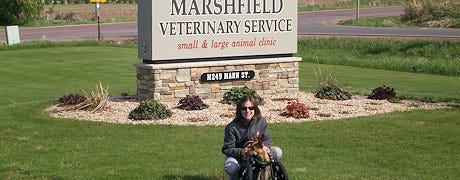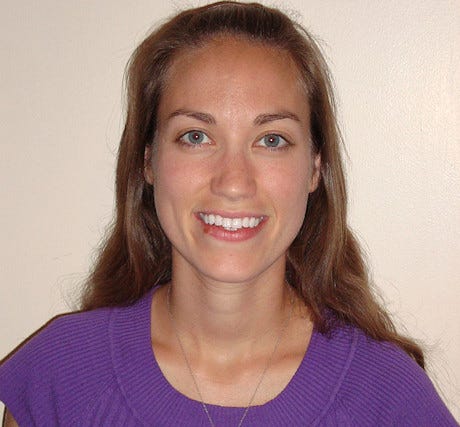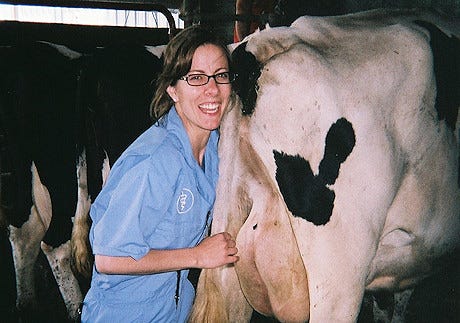June 19, 2012

By Jack Carson
Newly graduated veterinarian Melissa Magnotta didn't grow up around cattle - or any other farm animals for that matter. Living about an hour from New York City her only exposure to livestock came from a trip to the zoo.
Krystal Kidder, a year away from graduation, grew up in Nebraska but her only experience with beef cattle was driving by feedlots.

BRANCHING OUT: Melissa Magnotta got a large-animal data dump at a special 'externship' provided by Pfizer.
Even with exposure to large-animal practice in vet school - Magnotta at Oklahoma State and Kidder at Kansas State - both women say they had given no consideration to any type large-animal practice before a Pfizer Animal Health's "externship program" hooked them up four weeks working with beef- and dairy-cattle veterinarians. That program is designed to expose more vet students to large animal medicine, perhaps encouraging more to go into this type practice.
Today both women say their experiences with the program definitely changed their outlook on large-animal or mixed-practice veterinary medicine.
Magnotta, once a volunteer for the Connecticut Audubon Society helping injured wildlife, says she is now considering working in animal agriculture or at least in a mixed practice.
"I had taken some business, animal classes and of course worked with large animals in some of my classes but I hadn't really considered working in a mixed-animal practice as a career," she said. "I had friends (in Oklahoma) with cattle but never really thought it would be something I wanted to do. After working with Marshfield (Veterinary Services in Marshfield WI) - Oh, yeah, it really appealed to me!"

LEARNING MORE: For Krystal Kidder, the idea of working with large animals was foreign, but she really enjoyed the learning experience.
The Marshfield practice consisted of five large-animal and two small-animal veterinarians. Magnotta said the range and variety of work surprised her and she discovered she liked working with cattle. Perhaps a foreign concept to those who have spent entire lives and careers working with livestock, the reality is many future veterinarians have no experience and are going to be literally learning on the job.
"Every day we did something different and I liked it all," she said. "You learned something new every time you went out. This really made me think about where our food comes from and everything that goes into food animal production. I really liked being a part of it all."
The diversity in large animal agriculture was another thing she found surprising.
"We worked on everything from small mom-and-pop operations to huge, huge dairies," Magnotta says. "Everything was different and it really made a difference in how we had to respond."

HANDS-ON EXPERIENCE: Magnotta had little experience with large animal treatment, but has learned plenty in the program.
This is something both women refer to when talking about treating cattle: In addition to having no previous experience working cattle, both women say they had an initial hesitance about working with animals much larger than they are.
Kidder said her four-week externship with Corydon Veterinary Clinic in Corydon, Iowa, answered a question she had pondered since being accepted into vet school: How can I handle animals as large as cattle?
"They're so big and I'm so small, it was intimidating," she admits. "We had lady vets at the clinic as well as the university and I finally learned that it's the way you go about things that matters. You can work cattle if you have the technique. I know who Temple Grandin is now."
Still, it was actually working cattle with practicing veterinarians that finally made her comfortable enough to enjoy the work.
"One of the things I took away from the program was the emphasis on safety at the clinic," Kidder says. "My comfort level progressed due to my experiences with the program and I'm definitely interested in a mixed animal practice if the opportunity comes along."
The externship program provided something else to the girl from Nebraska who had no agricultural contacts. She was able to spend time with beef producers and learned some things about the industry.
"I was surprised by how interested the producers are about their animal's welfare," Kidder said. "The producers are all about their animals and that wasn't something I had expected. Their welfare and health of their animals is really part of the economic aspects of the cattle business and the clients are very easy to talk to because it's so important to them."
So, what are the chances either of these young women actually go into a large animal or mixed animal practice? Both say it's up in the air but the likelihood is better than when they first enrolled in vet school.
Kidder said she is dating a vet student who aspires to move to Montana and work in a large-animal practice. She says she can easily see the two of them working in a mixed practice. Magnotta said she doesn't have plans at this time but after living in Oklahoma for a while doesn't see New England in her future.
"I'll be going south," she said. "I'll definitely find my dirt road again."
Carson writes from Noble, Oklahoma.
You May Also Like




